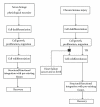Thyroid hormone and cardiac disease: from basic concepts to clinical application
- PMID: 21765997
- PMCID: PMC3134399
- DOI: 10.4061/2011/958626
Thyroid hormone and cardiac disease: from basic concepts to clinical application
Abstract
Nature's models of regeneration provide substantial evidence that a natural healing process may exist in the heart. Analogies existing between the damaged myocardium and the developing heart strongly indicate that regulatory factors which drive embryonic heart development may also control aspects of heart regeneration. In this context, thyroid hormone (TH) which is critical in heart maturation during development appears to have a reparative role in adult life. Thus, changes in TH -thyroid hormone receptor (TR) homeostasis are shown to govern the return of the damaged myocardium to the fetal phenotype. Accordingly, thyroid hormone treatment preferentially rebuilds the injured myocardium by reactivating developmental gene programming. Clinical data provide further support to this experimental evidence and changes in TH levels and in particular a reduction of biologically active triiodothyronine (T3) in plasma after myocardial infarction or during evolution of heart failure, are strongly correlated with patients morbidity and mortality. The potential of TH to regenerate a diseased heart has now been testing in patients with acute myocardial infarction in a phase II, randomized, double blind, placebo-controlled study (the THiRST study).
Figures




Similar articles
-
Thyroid hormone and cardiac repair/regeneration: from Prometheus myth to reality?Can J Physiol Pharmacol. 2012 Aug;90(8):977-87. doi: 10.1139/y2012-031. Epub 2012 Jul 4. Can J Physiol Pharmacol. 2012. PMID: 22762197 Review.
-
Thyroid hormone receptor α1 as a novel therapeutic target for tissue repair.Ann Transl Med. 2018 Jun;6(12):254. doi: 10.21037/atm.2018.06.12. Ann Transl Med. 2018. PMID: 30069456 Free PMC article. Review.
-
Effects of Thyroid Hormone on Tissue Hypoxia: Relevance to Sepsis Therapy.J Clin Med. 2021 Dec 14;10(24):5855. doi: 10.3390/jcm10245855. J Clin Med. 2021. PMID: 34945151 Free PMC article. Review.
-
Time-dependent changes in the expression of thyroid hormone receptor alpha 1 in the myocardium after acute myocardial infarction: possible implications in cardiac remodelling.Eur J Endocrinol. 2007 Apr;156(4):415-24. doi: 10.1530/EJE-06-0707. Eur J Endocrinol. 2007. PMID: 17389455
-
Thyroid Hormone and Heart Failure: Charting Known Pathways for Cardiac Repair/Regeneration.Biomedicines. 2023 Mar 21;11(3):975. doi: 10.3390/biomedicines11030975. Biomedicines. 2023. PMID: 36979954 Free PMC article. Review.
Cited by
-
Novel uses of thyroid hormones in cardiovascular conditions.Endocrine. 2019 Oct;66(1):115-123. doi: 10.1007/s12020-019-02050-4. Epub 2019 Oct 15. Endocrine. 2019. PMID: 31617169 Free PMC article. Review.
-
Cardioprotection and thyroid hormones.Heart Fail Rev. 2016 Jul;21(4):391-9. doi: 10.1007/s10741-016-9545-8. Heart Fail Rev. 2016. PMID: 27011011 Review.
-
Cell-type-dependent thyroid hormone effects on glioma tumor cell lines.J Thyroid Res. 2011;2011:856050. doi: 10.4061/2011/856050. Epub 2011 Dec 21. J Thyroid Res. 2011. PMID: 22229106 Free PMC article.
-
Thyroid hormones and cardiovascular disease.Nat Rev Cardiol. 2017 Jan;14(1):39-55. doi: 10.1038/nrcardio.2016.174. Epub 2016 Nov 4. Nat Rev Cardiol. 2017. PMID: 27811932 Review.
-
The impact of thyroid hormone dysfunction on ischemic heart disease.Endocr Connect. 2019 May 1;8(5):R76-R90. doi: 10.1530/EC-19-0096. Endocr Connect. 2019. PMID: 30959486 Free PMC article. Review.
References
-
- Pantos C, Mourouzis I, Cokkinos DV. New insights into the role of thyroid hormone in cardiac remodeling: time to reconsider? Heart Failure Reviews. 2011;16(1):79–96. - PubMed
-
- Swynghedauw B. Molecular mechanisms of myocardial remodeling. Physiological Reviews. 1999;79(1):215–262. - PubMed
-
- Rajabi M, Kassiotis C, Razeghi P, Taegtmeyer H. Return to the fetal gene program protects the stressed heart: a strong hypothesis. Heart Failure Reviews. 2007;12(3-4):331–343. - PubMed
LinkOut - more resources
Full Text Sources
Medical

